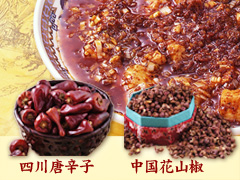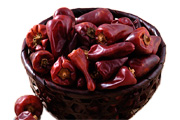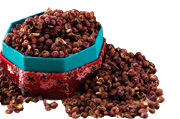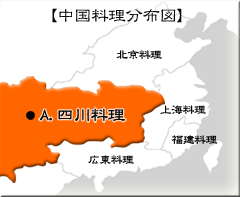 Keitokuchin-Shinkan / Keitokuchin-Shuka restaurants is one of the few specialty restaurants for Sichuan cuisine in Yokohama Chinatown where you can taste authentic Sichuan cuisine.
Keitokuchin-Shinkan / Keitokuchin-Shuka restaurants is one of the few specialty restaurants for Sichuan cuisine in Yokohama Chinatown where you can taste authentic Sichuan cuisine.
Sichuan cuisine is famous for its spiciness, but it is not just about being spicy. It has a unique flavor that comes from the combination of "La" (numbing spiciness from Sichuan peppercorns), "Ma" (tingling spiciness from Chinese prickly ash), "Xian" (Salty), and "Tang" (hot temperature).
These flavors are blended together to create a distinctive umami taste.
The restaurant uses authentic Sichuan spices from China, and has specialty chefs who create these flavors.
You can experience the
authentic taste of Sichuan cuisine at Keitokuchin-Shinkan / Keitoku
chin-Shuka.
 【Sichuan Pepper】
【Sichuan Pepper】
In Chinese, it is represented by the character "la" (辣), and is a type of chili pepper that is essential in Sichuan cuisine, known for its intense spiciness and is also referred to as "Choutian chili pepper" (朝天辣椒). In Chinese, "Chou" means to face or to head towards, while "Tian" means sky or heaven. Therefore, it is called "Choutian" because it grows towards the sky. It is about one size smaller than small Japanese bell peppers and is known for its strong
spiciness and distinctive aroma of hot peppers.
 【Chinese Sichuan Peppercorn】
【Chinese Sichuan Peppercorn】
In Chinese, it is called "huajiao" (花椒), and is represented by the character "ma" (麻), which means numbness or tingling sensation.
Similar to Japanese sansho pepper, it is an essential spice in Sichuan cuisine, which produces a numbing and spicy flavor on the tongue. It is commonly used together with the aforementioned "Sichuan Pepper" (辣) in Sichuan cuisine, and is a must-have ingredient in extremely spicy Sichuan dishes,
which are often labeled as "mala" (麻辣) in the dish's name.
 【Sichuan cuisine, one of the four major Chinese cuisines】
【Sichuan cuisine, one of the four major Chinese cuisines】
Sichuan cuisine is a type of Chinese cuisine that originated in Sichuan Province, located in the upper reaches of the Yangtze River. Due to the hot and humid climate of the Sichuan Basin, it is said that spices were used extensively for disease prevention and detoxification. In addition to the abundance of ingredients available in Sichuan, the cuisine is known for its exquisite seasoning, where skilled chefs use 30 to 40 types of seasonings and spices in a single dish, making it a truly surprising cuisine.
Before World War II, Sichuan cuisine was not well known in Japan. At that time, Beijing cuisine, Shanghai cuisine, and Cantonese cuisine were the most common types of Chinese cuisine. It was not until 1958 when the first restaurant specializing in authentic Sichuan cuisine opened in Shinbashi. After several years of the resumption of diplomatic relations between Japan and China in 1972, Japanese people were able to freely travel to various parts of China, including Sichuan Province, which became a popular destination for tourists. As a result, the number of Japanese travelers who tasted authentic Sichuan cuisine increased, and soon, many Chinese restaurants specializing in authentic Sichuan cuisine opened in Japan, offering representative dishes such as "Mapo tofu" and "Bang Bang chicken."
